|
 |
Home
» History History
20.06.2023
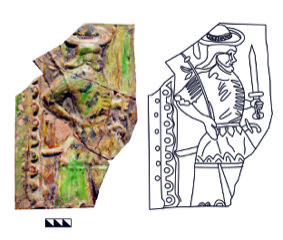 In 1995-2021, Ukrainian and Canadian archaeologists and historians conducted annual excavations in the town of Baturyn, Chernihiv Oblast (fig. 1). Last year, the field research was suspended due to Russia’s full-scale invasion of Ukraine. Nevertheless, scholars at the Canadian Institute of Ukrainian Studies (CIUS) at the University of Alberta, the Chernihiv College National University, and the Hetman Capital National Historical and Cultural Preserve, despite wartime conditions, have continued their investigations and publications on the history and culture of early modern Baturyn on the basis of abundant archaeological source materials collected in previous years. The Canada-Ukraine Baturyn Archaeological Project is administered by The Peter Jacyk Centre for Ukrainian Historical Research at the CIUS Toronto Office (https://www. ualberta. ca/canadian-institute-of-ukrainian-studies/centres-and-programs/jacyk-centre/ baturyn-project.html). Prof. Zenon Kohut, a former director of CIUS and an eminent historian of... In 1995-2021, Ukrainian and Canadian archaeologists and historians conducted annual excavations in the town of Baturyn, Chernihiv Oblast (fig. 1). Last year, the field research was suspended due to Russia’s full-scale invasion of Ukraine. Nevertheless, scholars at the Canadian Institute of Ukrainian Studies (CIUS) at the University of Alberta, the Chernihiv College National University, and the Hetman Capital National Historical and Cultural Preserve, despite wartime conditions, have continued their investigations and publications on the history and culture of early modern Baturyn on the basis of abundant archaeological source materials collected in previous years. The Canada-Ukraine Baturyn Archaeological Project is administered by The Peter Jacyk Centre for Ukrainian Historical Research at the CIUS Toronto Office (https://www. ualberta. ca/canadian-institute-of-ukrainian-studies/centres-and-programs/jacyk-centre/ baturyn-project.html). Prof. Zenon Kohut, a former director of CIUS and an eminent historian of...
|
Detailed...
|
14.12.2022
Commissioned by the Center of Historical Political Science of the Institute of Political and Ethnonational Studies of the National Academy of Sciences of Ukraine, I have just completed the manuscript about Avraam Shifrin. This book will join a large-scale publishing project, a series titled "Political Portraits" by the Parliamentary Publishing House of the Verkhovna Rada of Ukraine. I have had the honor of writing the political portrait of Avraam Shifrin, a man of amazing fate and unwavering will; he was born the son of a man labeled an “enemy of the people.” Shifrin was a veteran of the Second World War, at the end of which he held the title of officer in the Red Army at only 22 with a rank of major and with an injury that rendered him with a medium level disability. He became a senior criminal investigator, legal adviser to the Ministry of Armaments of the USSR, and an American-Israeli spy who had access to top-secret documents signed by Stalin. He was also a prisoner of the Gulag for 10 years, a Zionist, publicist, human rights defender, writer, translator, Israeli public and political figure, and an expert on the Soviet penitentiary system; according to the Soviet press he was the “number 1 enemy of the USSR.”... |
Detailed...
|
23.11.2021
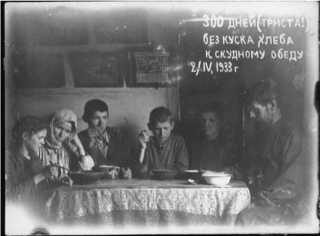 The deleterious effects of artificially inflated Holodomor death tolls The deleterious effects of artificially inflated Holodomor death tolls
A family at the time of the Holodomor is seen gathered around their meager meal.
300 days without a piece of bread to the meager dinner, 2.4.1933.
Photo from the private archive of Mykola Bokan, State Archive of the Security Service of Ukraine.
The scientifically sound estimate of the number of Ukrainians who starved to death in Stalin’s Holodomor famine is roughly 4 million. Yet, many scholars attempt to impose unrealistically inflated numbers — up to 15 million. This does no justice either to the victims, o... |
Detailed...
|
12.01.2021
I look around, I am surrounded by silence. The only noise for miles was my growling stomach and my thoughts telling me it cannot end like this. As I slowly make my way towards the river, crawling with all the strength I have left, I think about how I got here. A tear shed from my sullen eyes, thinking of how it used to be, before the Soviets. It all started less than a year ago in the fall of 1932. In our house lived my parents, my baba, my three siblings and me. I was the second oldest and therefore only had a small number of responsibilities. I would wake up early every morning to feed our animals. This was an important job until one day the soldiers came and took the animals to collective farms. My father resisted at first but turned very quickly quiet after one of the soldiers pointed a gun directly between his eyes. However the neighbor who argued with the brigades was not as lucky. Stalin sent soldiers daily, each day taking more and more food away from us. My father was forced to work in a collective farm to ensure we would not starve to death while my mother hid icons, food, and valuable items including our millstone. The entire village was rattled, nobody knew what to do or what was going to happen. There was a knock on our door from the brigades once again. They wanted to... |
Detailed...
|
29.12.2020
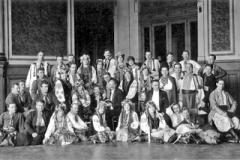 A group of men and women in traditional embroidered dress took the stage at Carnegie Hall on Oct. 5, 1922, for a performance that the New York Tribune dubbed “a marvel of technical skill.” The New York Times called the music they made “simply spontaneous in origin and artistically harmonized.” The New York Herald described the costume-clad singers as expressing “a profound unanimity of feeling that aroused genuine emotion among the listeners.” The audience that cheered for encores and threw flowers on the stage didn’t know it at the time, but they had just heard what would eventually become one of the world’s most beloved and recognized Christmas songs: “Carol of the Bells.” Onstage was the Ukrainian National Chorus conducted by Alexander Koshetz. At the end of Part 1 of the program at Carnegie Hall, they performed composer Mykola Leontovych’s arrangement of a traditional Ukrainian song the playbill called “Shtshedryk.” The audience likely also did not know that just over a year before the New York premiere, Leontovych had been assassinated by the Cheka—the Bolshevik secret police. The song’s journey... A group of men and women in traditional embroidered dress took the stage at Carnegie Hall on Oct. 5, 1922, for a performance that the New York Tribune dubbed “a marvel of technical skill.” The New York Times called the music they made “simply spontaneous in origin and artistically harmonized.” The New York Herald described the costume-clad singers as expressing “a profound unanimity of feeling that aroused genuine emotion among the listeners.” The audience that cheered for encores and threw flowers on the stage didn’t know it at the time, but they had just heard what would eventually become one of the world’s most beloved and recognized Christmas songs: “Carol of the Bells.” Onstage was the Ukrainian National Chorus conducted by Alexander Koshetz. At the end of Part 1 of the program at Carnegie Hall, they performed composer Mykola Leontovych’s arrangement of a traditional Ukrainian song the playbill called “Shtshedryk.” The audience likely also did not know that just over a year before the New York premiere, Leontovych had been assassinated by the Cheka—the Bolshevik secret police. The song’s journey...
|
Detailed...
|
13.10.2020
Oleksandr Kosmach, a photographer from Kyiv with a love for history, collects historical stamps issued by Ukrainian diaspora organizations in the XX century. A photo article about these stamps, which served as political propaganda for an independent Ukrainian state while it was part of the USSR, was published by The Guardian/The Observer, but subsequently deleted without explanation. Mr. Kosmach supposes that references to the Ukrainian Insurgent Army and accusations of “Russophobia,” were the reason for the censorship. Here we bring you the stamps from Mr. Kosmach’s collection published in The Guardian/The Observer, information about the stamps, and Mr. Kosmach’s investigation into the fact of the deletion... |
Detailed...
|
04.06.2019
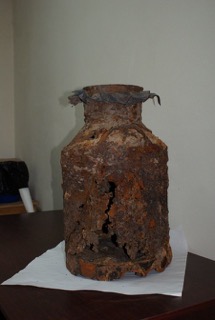 On April 27, 2019, the National Memorial Museum Tiurma na Lontskoho (Prison on Lontsky) in Lviv received historical OUN material found on the outskirts of the villages of Lanivka and Biynych, Stryy Raion, Lviv Oblast. In addition to invaluable documents, the milk can also contained interesting medical supplies. The milk can was accidentally found by local villagers on April 25 and, with the assistance of Galinfo journalists, was subsequently transferred to the museum for restoration. According to preliminary findings, the documents probably belonged to the Medenytsky District Command of the Organization of Ukrainian Nationalists (OUN). As of 1945, the Medenytsky District Command was under the Stryy District Command, and later under the Drohobych District Command. The documents probably date back to somewhere between 1947 and 1950... On April 27, 2019, the National Memorial Museum Tiurma na Lontskoho (Prison on Lontsky) in Lviv received historical OUN material found on the outskirts of the villages of Lanivka and Biynych, Stryy Raion, Lviv Oblast. In addition to invaluable documents, the milk can also contained interesting medical supplies. The milk can was accidentally found by local villagers on April 25 and, with the assistance of Galinfo journalists, was subsequently transferred to the museum for restoration. According to preliminary findings, the documents probably belonged to the Medenytsky District Command of the Organization of Ukrainian Nationalists (OUN). As of 1945, the Medenytsky District Command was under the Stryy District Command, and later under the Drohobych District Command. The documents probably date back to somewhere between 1947 and 1950...
|
Detailed...
|
19.02.2019
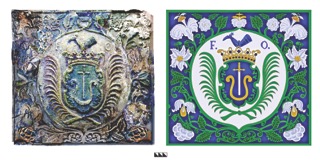 During the war in Ukraine, conditions for carrying out excavations in Baturyn, Chernihiv Oblast, have remained difficult. Notwithstanding, the historical and archaeological research of the town has progressed well in 2017-2018. These years, Baturyn excavations engaged 95 students and scholars from Chernihiv and Hlukhiv universities and the Institute of Archaeology of the National Academy of Sciences of Ukraine in Kyiv. Archaeologist Yurii Sytyi of the Chernihiv College National University leads the Baturyn archaeological expedition. Archaeologist Dr. Volodymyr Mezentsev (Canadian Institute of Ukrainian Studies, Toronto) is the executive director of the Canada-Ukraine Baturyn project. From 1669 to 1708, Baturyn was the capital of the Cossack state, or Hetmanate. It had become known in the West as the major, prosperous, and... During the war in Ukraine, conditions for carrying out excavations in Baturyn, Chernihiv Oblast, have remained difficult. Notwithstanding, the historical and archaeological research of the town has progressed well in 2017-2018. These years, Baturyn excavations engaged 95 students and scholars from Chernihiv and Hlukhiv universities and the Institute of Archaeology of the National Academy of Sciences of Ukraine in Kyiv. Archaeologist Yurii Sytyi of the Chernihiv College National University leads the Baturyn archaeological expedition. Archaeologist Dr. Volodymyr Mezentsev (Canadian Institute of Ukrainian Studies, Toronto) is the executive director of the Canada-Ukraine Baturyn project. From 1669 to 1708, Baturyn was the capital of the Cossack state, or Hetmanate. It had become known in the West as the major, prosperous, and...
|
Detailed...
|
09.01.2019
Practically all journalists and academics writing about the Volyn massacres in 1943 do so in a one-sided manner. This bias is reflected in four ways: 1. Choosing a short time period of one year (1943) and ignoring what happened before and after; 2. Only criticizing Ukrainian nationalism; 3. Blaming only the Ukrainian side for the poor state of Polish-Ukrainian relations... |
Detailed...
|
10.05.2017
After the establishment of new borders between the USSR and its new satellite the Polish Peoples' Republic as a consequence of World War II, only 700,000 Ukrainians remained on the territory of Poland. Between the two world wars on the territory of the Second Polish Republic the Ukrainian population was over 5 million. With the establishment of new borders a Soviet-Polish joint action of "voluntary resettlement" was initiated. Soon the voluntary facade was dropped in favor of "forcible repatriation." Yet in January 1947 when the joint action had been completed seemingly, the Polish government realized that more than 150,000 indigenous Ukrainians remained in Poland... |
Detailed...
|
|
|
| NEW NAME OF BUDUCHNIST CREDIT UNION |
|
|
|
|




